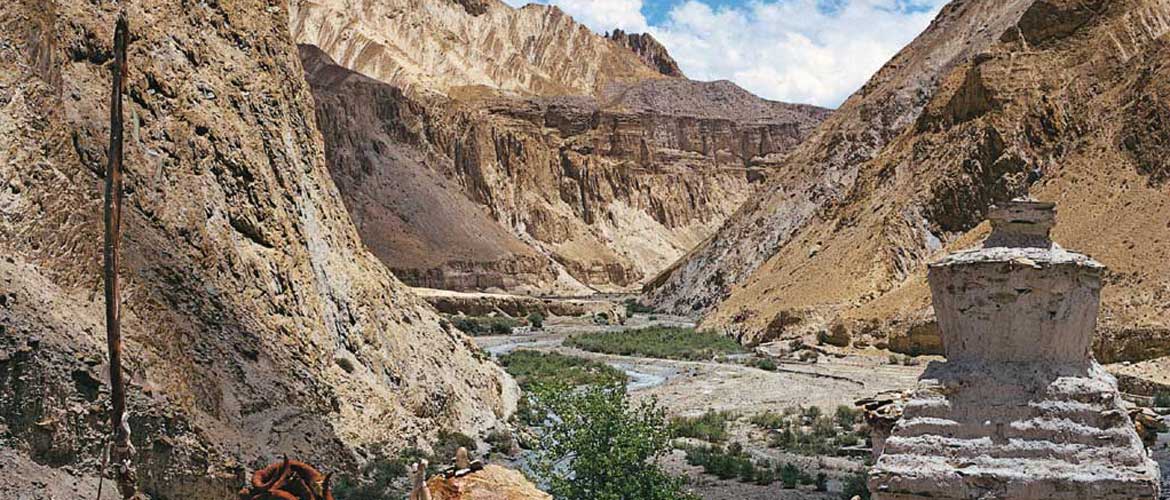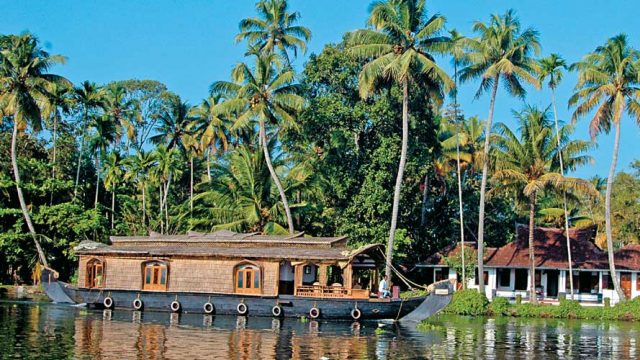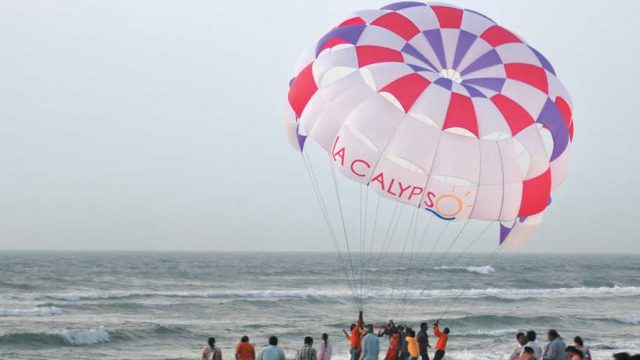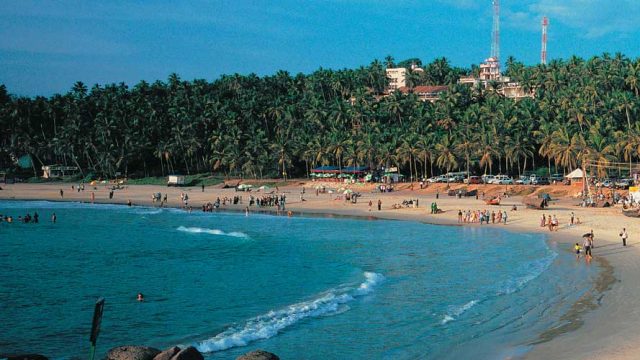The Route: Spituk-Zingchan-Kanda La Base Campskiu-Markha-Thujungtse-Tsigu-Nyimalingshang Sumdo-Hemis With every second shop in the Leh
The trek itself is thrilling. It’s set in part in the beautiful Hemis National Park, with two 4,800-5,000 m high passes to cross. There are waist-deep rivers to ford too. This trek satisfies the most demanding of adventurers. Add to that the pleasure of campsites set among aromatic shrubs and wild roses. You can spot bharal (blue sheep), nearly totally disguised on the bare mountains. Or chuckle at the antics of the phia (marmot) as you end up enjoying quite the perfect holiday.

DAY ONE
SPITUK-ZINGCHAN
TIME 4-6 HOURS
LEVEL MODERATE-EASY
The trek traditionally starts at the bridge over the Indus about a kilometre west of Spituk Village. However, a jeepable road slated to connect Spituk runs nearly all the way to Zingchan and if you get your taxi to drop you 7 km down the road to the point opposite Phey Village, you can skip the 2 hr-long hot walk over unchanging scree-filled landscape (particularly after the Spituk Pharka Village) From this point it is a fairly pleasant walk along the descending road in a southwesterly direction along the Indus on your right, until you arrive at a fork where a swiftly flowing stream joins the Indus from the left. Walk into the valley due south, across the bridge, which can be a pleasant resting point. A walk of a couple more kilometres will bring you to a road sign: ‘Jhingchan to Rumbak Road 1.00 km’. Look out for the log bridge here — nothing more than a few poplars lashed together — which often gets washed away. If there is no bridge you will have to ford the thigh-deep stream. After crossing it, find the path heading south-east which climbs suddenly onto the hillside to Zingchan Village.
There are two campsites here — one just before you climb up and one past the village down by the stream, called the Daisy Campsite. I preferred to walk a little further for an hour, crossing the stream once more on a bridge, past a Forest Checkpoint with a sign welcoming you to Hemis National Park. Continue up the well-defined path, crossing the nullah at least four times before you arrive at Sumdzom, marked by a stone chorten with prayer flags and a grove of willows and wild roses. There are good camping options here.
Entry fee to Hemis National Park ₹20 per person per day

DAY TWO
ZINGCHAN-KANDA LA BASE CAMP
TIME 5-6 HOURS
LEVEL MODERATE-TOUGH
From Sumdzom walk upstream on the left bank (true right bank), crossing the stream twice over sturdy wooden bridges. Then climb steadily up the hill as the path moves due south-east until it comes out of the narrow gorge. Straight in front is the Kanda La Nallah, along which a path leads to high pastures. On your left, or east, is the path which leads up to Rumbak Village. And up ahead, crossing the nallah and to the right is the path leading to Nyurutse and the Kanda La Base Camp. This junction is a pretty spot with wild flowers and a tea shop, a perfect resting place. Follow the Nyurutse path as it climbs steadily southwards. Nyurutse is a tiny hamlet and you can rest here, but see if you can press on for another hour that will bring you to a parachute-tent tea shop (shops in tents that come up during the season).
There are plenty of camping spots right after Nyurutse and even after the tea shop, but if you are a small group then head up south-west to the Kanda La Base Camp for the night. This is a small flat piece of land with a water source. It commands very nice views of the valley below, besides cutting short the sharp climb up to the pass the next morning.
DAY THREE
KANDA LA BASE CAMP-SKIU
TIME 7-8 HOURS
LEVEL TOUGH
Set out early, particularly if you have camped below the Kanda La Base Camp last night as today is a long day. The trek up to the Kanda La Pass (15,978 ft) takes a little under 2 hrs of steady climbing from the base camp. Follow the path south around the hill and then, instead of going straight up the pasture, find a path to the right or west which zigzags up to the pass marked by prayer flags. Look out for marmots en route. From the pass, a well-defined path leads down to Shingo. This is a surprisingly long descent on a well-defined path, taking around 2 hrs to the parachute tent tea shop.

From Shingo, head south along the village wall and as you come out into open fields, look for a path to your left, or east, which heads steadily downhill in a south-easterly direction through a narrow gorge filled with wild roses. The path to Skiu is very well defined except that you have to cross the Shingo Nallah at least four times. It’s a shallow stream except in one or two places and it’s pleasant to get your toes wet. From Shingo, it should take you no more than 3 hrs even if you factor in a longish lunch break. Skiu, situated in the Markha Valley, which runs west to east, is a fascinating place with ruins of ancient monasteries.
There are two campsites at Skiu, a small one as soon as you enter the village, and a more favoured one just past Skiu, by the Markha River. One can have a lovely rest day here, bathing in the river and doing a side trip westwards into the Zanskar Gorge to the village of Kaya.
DAY FOUR
SKIU-MARKHA
TIME 6-7 HOURS
LEVEL MODERATE
If you have rested the day before, today will be relatively easy as you are walking on more or less level ground in the Markha Valley. From the second campsite, head a few hundred metres north to the edge of the pasture and find a broad path going east. After a few kilometres, you will come to a broken bridge across the river. Do not cross but continue walking upstream, heading east, into the thicket of willows and out. You will be walking either at the base of the hill or on a path cut into its side. About 7 km from Skiu, the path climbs up and abruptly confronts a high, but sturdy wooden bridge across the Markha. From here, it is a couple of kilometres to Sara where one can stop for some hot tea and refreshments.

Soon after, the path descends to another solid bridge crossing over to the true right of the valley into the village of Chalak. The path then climbs steadily eastwards up to a ridge which has some very weathered, large Mani walls, some painted red, replete with prayer flags and bharal horns. Descend to the valley floor, crossing a small, swift stream, and continue eastwards on the true right of the valley for about an hour. Then cross the cold, thigh-deep, swift Markha River. Ensure that your guide picks the shallowest spot and helps you cross to the true left of the valley. A couple of kilometres later the path descends to a bridge.
There is a walled campsite here as well as across the bridge, close to the Markha Village, fort and monastery. Spend the evening exploring these.
DAY FIVE
MARKHA-THUJUNGTSE-TSIGU
TIME 7-8 HOURS
LEVEL TOUGH
Today is a long day, particularly if you are camping at Tsigu. From the campsite, skirt the hill, past the primary school (no need to climb up the main path to the fort), cross the small stream and head east past the fields. After a few kilometres you will find a bridge across the river. Ignore this and continue on the path up the rise and down onto the river bed. The Markha River traces a wide ‘U’ so it needs to be crossed twice within a couple of hundred metres. The river is deep and swift, so ensure that you have help while crossing. Climb up the bank, past mani walls, heading in a south-easterly direction, passing the Teja Gompa and climbing gently up to the tea-stall at Umlung.

From here, the clearly defined path continues in a south-easterly direction, first climbing a small rise and then dropping down to a large, flat plain with some fenced fields. The Kangyatse Peak (20,997 ft) dominates the landscape. Keep on going until you reach the small settlement of Lower Hankar. From here the path runs downhill to the river and sharply veers to the left, or north, and leads up a very steep slope up to a ridge which has the remains of an old fort. From here Upper Hankar village opens up before you. Follow the path down into the valley eastwards, until the path veers left, or north, into a narrow gorge, then east and upwards again to Thujungtse.
If you are a large group, then it’s better to camp here. If not, walk another hour to Tsigu, located in a cirque with a couple of small tarns. The views from here are spectacular. Walk uphill, north-east through a stream, and right (east) around a hill. There is a path that moves up to your left. Do not take that. Walk straight (north) up the valley in front of you, keeping to the right of the valley until you come to a fork that moves right. Do not take this. Look to your left (west) instead and find a path zig-zagging steeply to the top. On the ridge you will find the clearly defined path going northwards to the campsite, 10 mins away.
DAY SIX
THUJUNGTSE-TSIGU-NYIMALING
TIME 1½-3 HOURS
LEVEL EASY
Nyimaling is a beautiful, broad, grassy valley with plenty of water. If you have stopped at Tsigu for the night, then you can do the side trip from Nyimaling to Kangyatse Base Camp on the same day. If you are walking from Thujungtse, it may be too tiring. Either way, you may want to factor in another rest day here.
From Tsigu, find the well-defined path heading east in a series of switch backs until you come down into the broad valley with a parachute-tent tea house marking the Nyimaling campsite.
SIDE TRIP TO KANG YATSE BASE CAMP
TIME 4-5 HOURS
From the Nyimaling campsite, take your guide and a picnic lunch and head due south, ascending gently over pasture land for a couple of hours until you reach the snow line, marking the base camp of the mountain. Head back the same way.
DAY SEVEN
NYIMALING-SHANG SUMDO
TIME 7-8 HOURS
LEVEL TOUGH
Across the stream to the north are a few homes, which make up the village of Nyimaling. Find the path that goes past them ascending steeply to the Kongmaru La at 16,831 ft, marked by prayer flags. It should take you 2-3 hrs to the top. From here the descent is sharp and treacherous. A little over an hour should bring you to Lhartse, a small campsite where you can take a break. From here, follow the path along the small stream. This flows into a narrow gorge where you must watch for rock fall. There are some places where the path disappears and you have to clamber over boulders. Do not be tempted to climb the shepherds’ paths on the true right of the gorge. Stick to the left as the gorge broadens and look out for a well-built paved path on the left that climbs the side of the gorge. Stop for tea at Chuskyurmo. Then continue north, past Chokdo village and on to Shang Sumdo, where there are many campsites. There’s a jeepable road to Shang Sumdo, so you can arrange to end your trek here.
DAY EIGHT
SHANG SUMDO-HEMIS
TIME 3-4 HOURS
LEVEL EASY
Spend the early morning exploring the side valley and the monastery of Shang. Then set out along the jeepable road to Martselang. Here, leave the main road, and head west on a path which goes over the scree slopes all the way to Hemis Monastery, from where you can continue on by taxi to Leh.
Time 6-8 days
Level Moderate to Tough
Ideal Season Mid-Jun to late Sep
Location Southwest of Leh, between the Stok and Zanskar ranges
GETTING THERE AND OUT
FROM Leh to Spituk, it’s 8 km/20 mins by car (₹180) or half an hour by bus (7.30 am-9 pm, and run every half-hour; fare ₹10). You can also ask the taxi to drop you beyond Spituk Pharka Village at the point opposite Phey Village, which is on the other side of the Indus River (12 km/40 mins; fare ₹280)
RETURN Get picked up at Shang Sumdo (52 km/1½ hrs; taxi ₹1,250 ) or Martselang (47 km/1 hr; taxi ₹1,000). The last bus to Leh (fare ₹30) leaves from Shang Sumdo at noon
TIP Always call a travel agency before setting the exact dates for this trek. Sometimes summer comes early and the passes open quicker, and sometimes the winter sets in early, causing an autumn trek to be scuttled
India
Ladakh
The Markha Vally Trek





